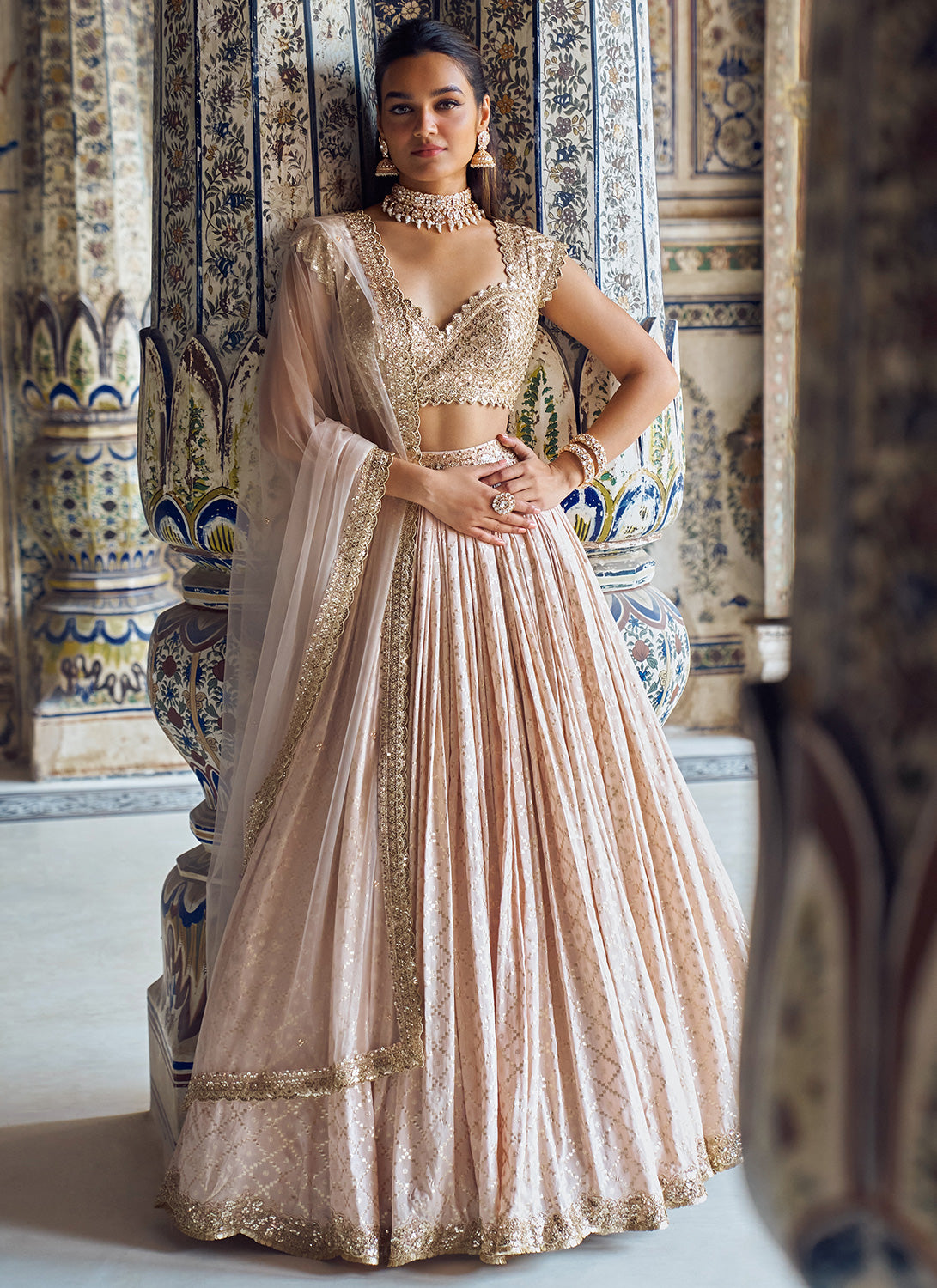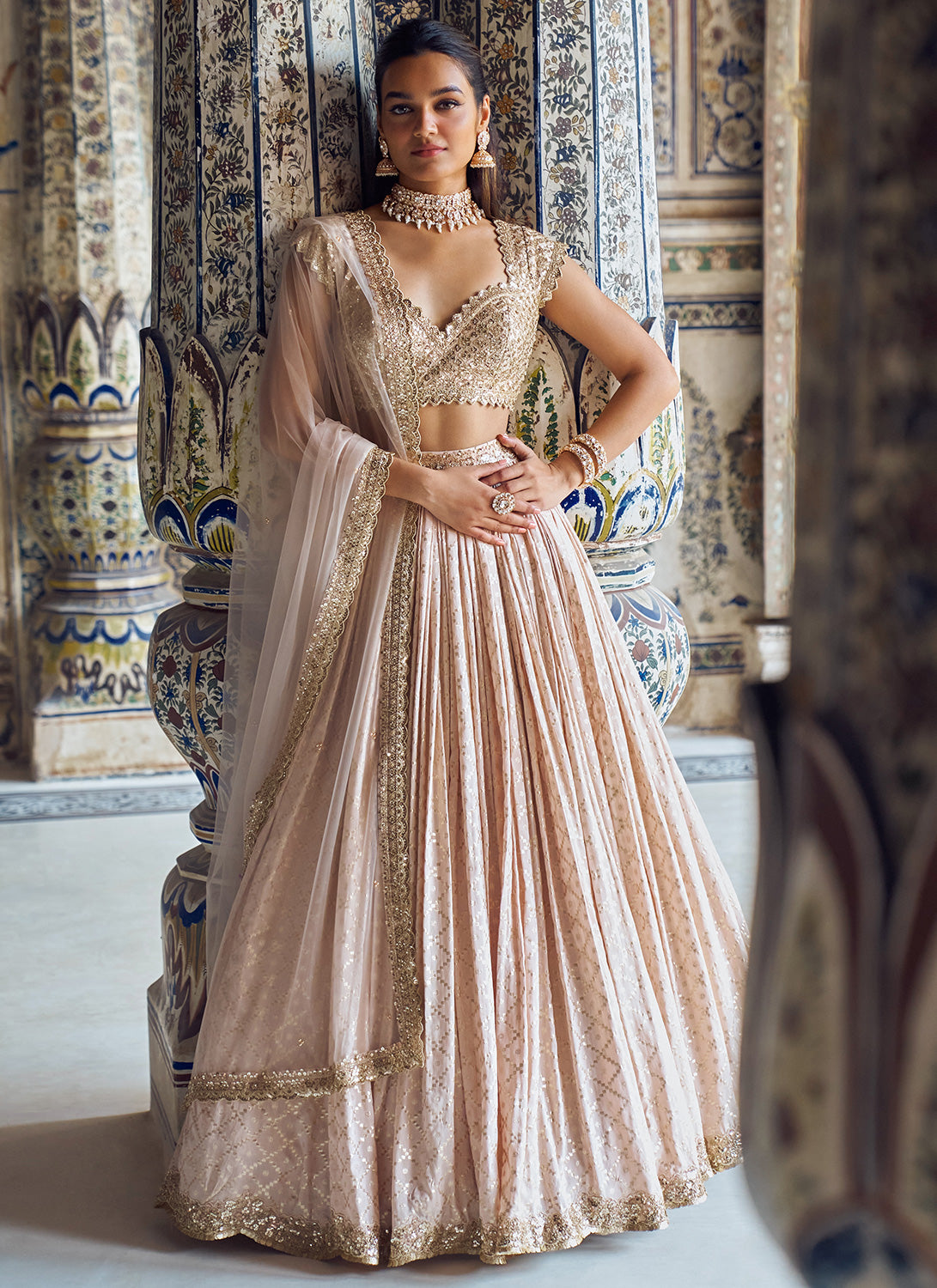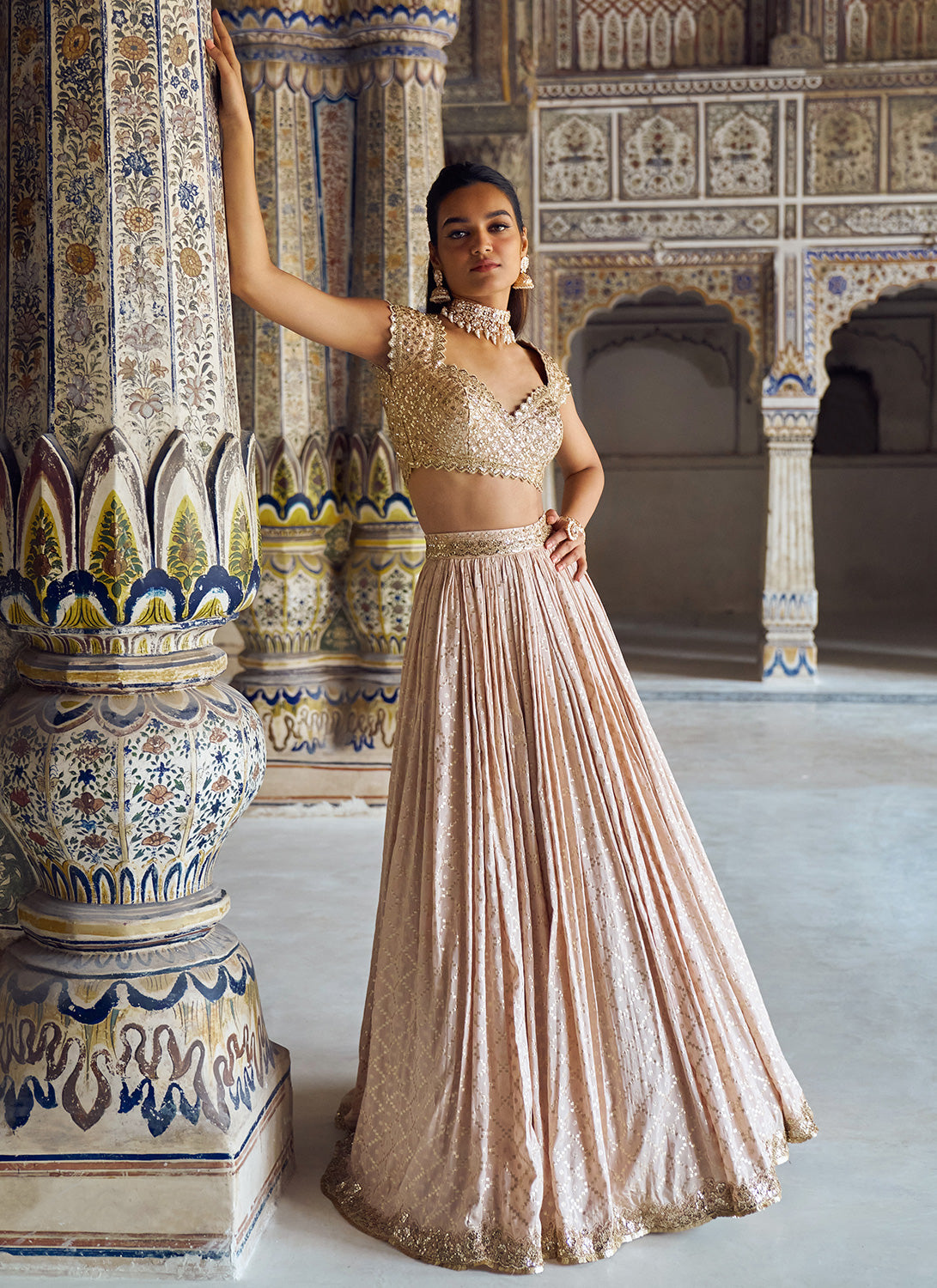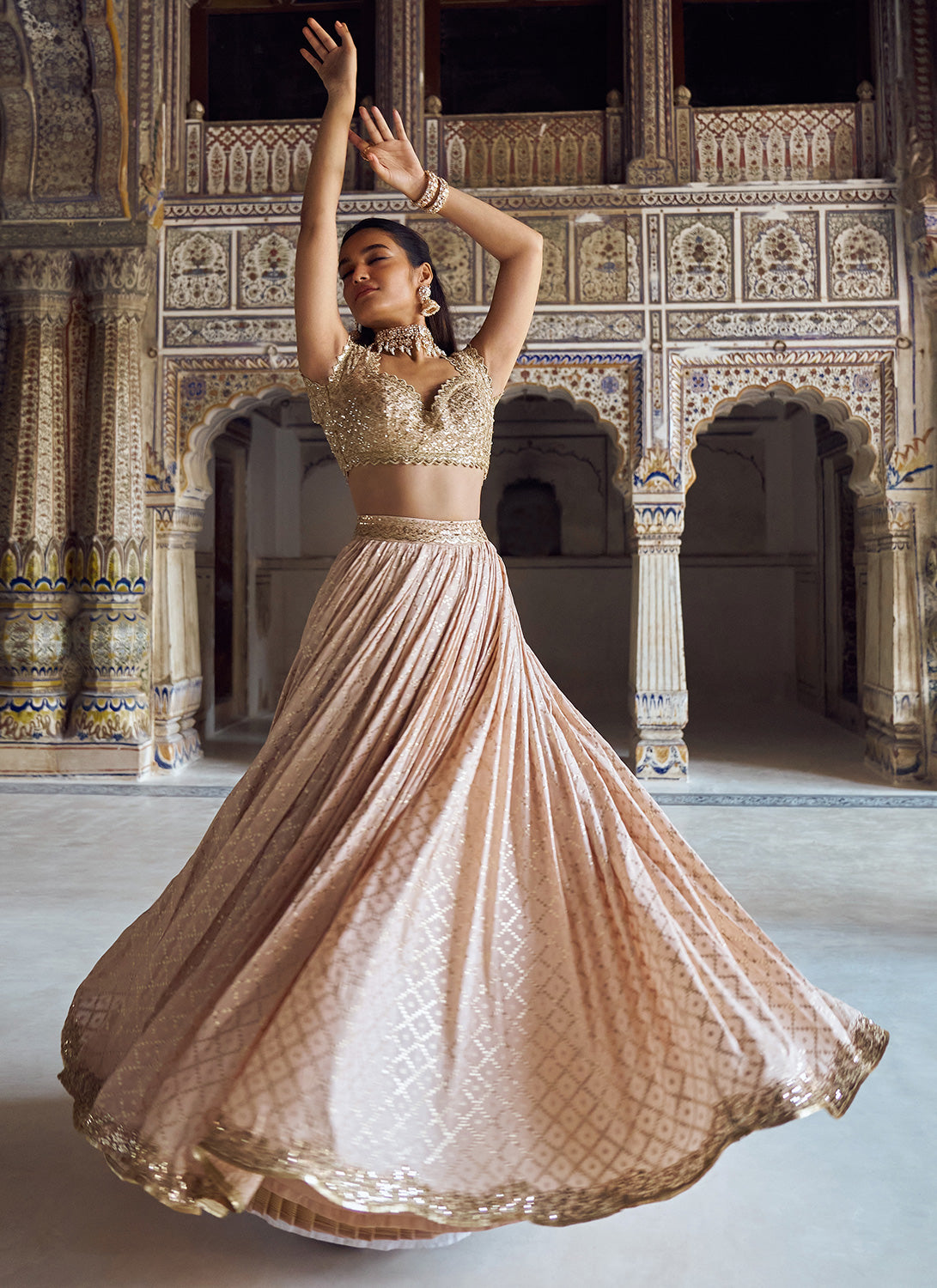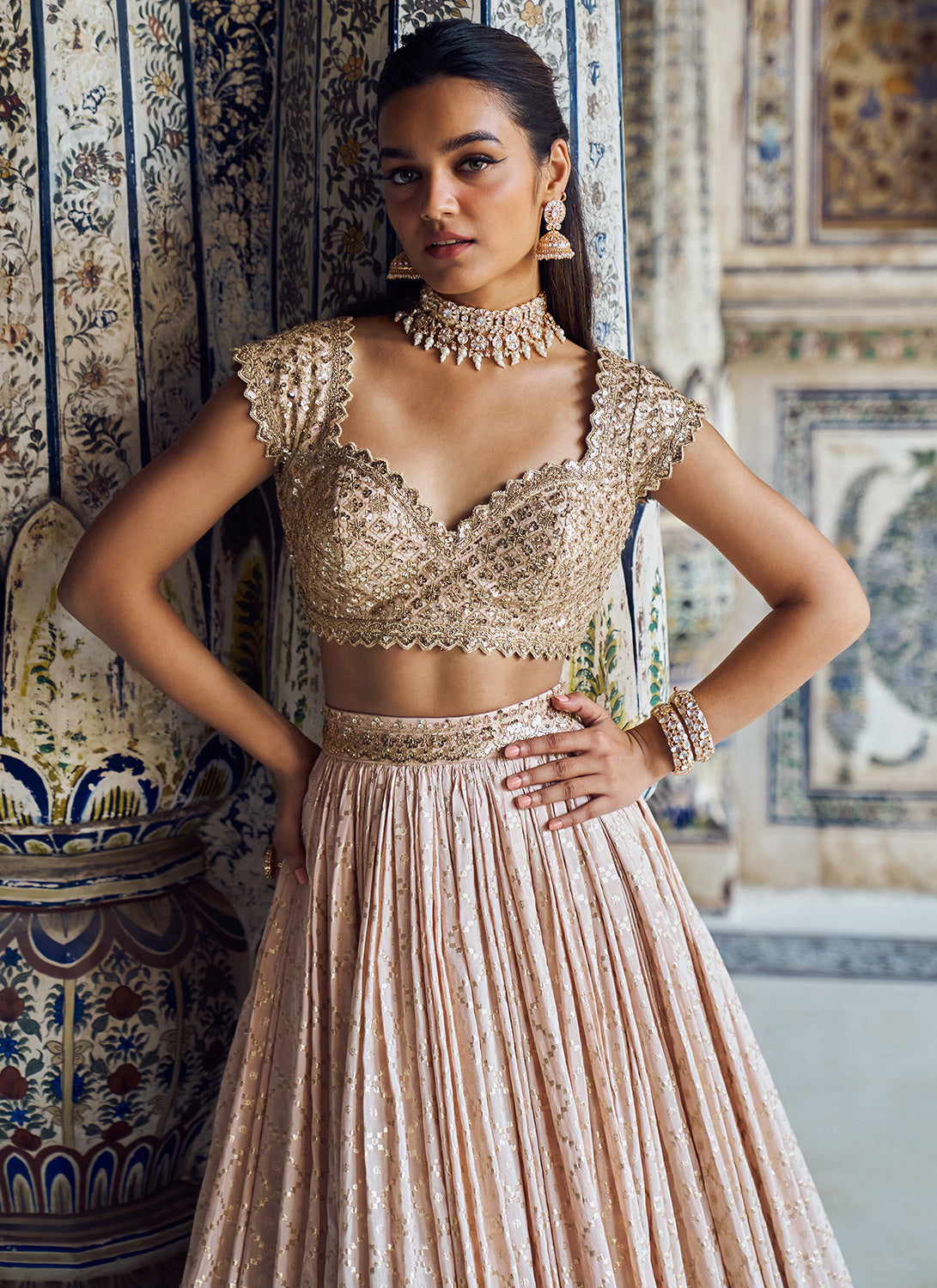The unique craft of embroidery was first documented as early as the 5th century BC and can be found in the ancient Indian ‘Vedas’. The beauty of Indian embroidery is that it has adopted and accepted a lot of traditional elements of varying cultures and geographical areas.
To add to this, the craftswomen quite creatively approached the process of pattern assimilation and embroidery techniques, making Indian embroidery extremely unique and visually stunning.
What is Indian Embroidery?
Indian embroidery refers to the intricate and colorful art of decorating fabric using needle and thread, often combined with mirrors, beads, sequins, and metallic embellishments. Rooted in centuries-old traditions, Indian embroidery serves not just an ornamental purpose but also carries social, spiritual, and symbolic significance.
Used widely in ethnic clothing, such as sarees, lehengas, dupattas, sherwanis, and salwar suits, these embroidery styles vary dramatically across regions. From the flamboyant mirror work of Gujarat to the poetic restraint of Chikankari from Lucknow, each technique reflects its cultural roots, local motifs, and the materials available in that area.
Embroidery is applied to a variety of textiles including cotton, muslin, silk, georgette, velvet, and even wool. Some techniques use only thread, while others integrate gold or silver wire, mirrors, beads, shells, or sequins to enhance richness and texture. Whether hand-stitched or machine-assisted, every embroidered piece adds depth and dimension to Indian fashion, making it both artistic and tactile.
Lashkaraa features many garments with regional embroidery accents, keeping these time-honored traditions alive in contemporary silhouettes.
The Importance of Embroidery in Indian Tradition
Indian embroidery is an intimate expression of a region’s heritage and a person’s identity. Let's dive deeper into these timeless traditions and how they've evolved.
Embroidery as Cultural Expression
Across India, embroidery techniques have long been tied to local rituals, caste systems, storytelling traditions, and the environment. Women in rural areas often create embroidered textiles for domestic use or as part of a bride's trousseau. Each stitch becomes part of a larger story, expressing love, spirituality, fertility, or folklore.
For instance, Kantha quilts in Bengal are often made from layers of old saris, repurposed with embroidered depictions of animals, plants, and mythological scenes. In contrast, Toda embroidery serves as a sacred tradition, passed down orally through generations of women in Tamil Nadu.
Many communities believe that embroidered garments provide protection—mirrors ward off evil, paisleys signify fertility, and lotus motifs symbolize purity and rebirth. These beliefs elevate embroidery to a cultural and even spiritual art form.
Bridal and Festive Embroidery in India
Bridalwear in India is synonymous with embroidery. On the most important day of her life, a bride dons garments lavishly adorned with symbolic threads: the gold of Zardozi, the sparkle of Gota Patti, or the intricate storytelling of Aari work.
Festivals such as Navratri, Eid, Diwali, and Baisakhi also call for embroidered attire. Each region dresses in its finest, and embroidery becomes a visual language of celebration. These pieces are often heirlooms, carefully preserved and passed on to future generations.
13 Types of Indian Embroidery Work
Among the variety of embroidery techniques and traditions found in the country, here are the most popular types of embroidery across different regions in India.
1. Mirror Work or Abhla Bharat (Gujarat, Rajasthan)
Abhla Bharat, or mirror work, is an exuberant embroidery style where small reflective mirrors are hand-stitched onto fabric using colorful thread. These mirrors are surrounded by geometric stitches, sunbursts, and floral patterns, which make the fabric sparkle in the sunlight.
Originating in the 17th century in India, the craft emerged when people from lower classes imitated the jeweled garments of the wealthy by decorating fabric with silver beetles’ wings and chips of mica. When a process for manufacturing tiny mirror discs was developed during the Mughal Empire, these tiny mirrors, known as shisha, were swiftly adopted for fabric embellishment.
The origins are tribal, rooted in the belief that mirrors reflect evil spirits and offer protection. Today, this style is widely used in cholis, skirts, dupattas, and decorative wall hangings, especially during folk festivals like Navratri.
A celebration of light and craft, this Lavender Lehenga features intricate mirror embroidery that adds sparkle to every step. Reflective accents are hand-stitched across delicate threadwork, creating a luminous contrast against the soft pastel hue.
2. Aari Work (Pan-India, Especially in Bridal Couture)
Aari embroidery involves the use of a hooked needle, similar to tambour work, to create continuous chain stitches. This technique allows for detailed patterns and is often embellished with beads, sequins, stones, and metallic threads.
Common motifs include floral vines, paisleys, and Mughal-inspired jaals. Aari work is frequently used in bridal lehengas, gowns, and designer ethnic wear due to its rich, textured appearance and precision.
3. Zardozi & Zari Work (North India, Mughal Influence)
Zardozi is the epitome of regal Indian embroidery. It involves gold or silver threads (called zari), sometimes combined with sequins, pearls, and gemstones. Used extensively during the Mughal period, it was reserved for nobility. The motifs often include peacocks, elephants, the Tree of Life, and architectural patterns, all crafted with fine precision on rich fabrics such as velvet, satin, and silk.
Drenched in regal elegance, our Bottle Green Silk Lehenga features intricate zari embroidery that glimmers with timeless charm. The rich gold threadwork highlights traditional motifs, creating a perfect balance of heritage and grandeur—ideal for weddings, sangeets, or festive celebrations.
Luxurious and statement-making, the Rust Velvet Lehenga is adorned with intricate embroidery that catches the light with every movement. The rich hue paired with detailed thread and sequin work evokes vintage opulence—perfect for winter weddings and evening occasions. Zardozi is commonly seen in bridal wear, sherwanis, and ceremonial accessories, such as bags and clutches.
4. Resham (Kashmir and Punjab)
Made from raw silk thread, resham is renowned for its soft, luxurious texture, vibrant colors, and intricate designs, often featuring floral, paisley, or other decorative patterns with a creeper-like motif.
5. Chikankari (Lucknow, Uttar Pradesh)
Famously known from the city of Lucknow in Uttar Pradesh, chikankari features a range of stitches, including bakhiya (shadow work), murri (knot), and jaali (netting), typically done with white thread on light fabrics such as muslin, chiffon, or georgette.
The motifs are inspired by Persian and Mughal aesthetics, featuring floral vines, paisleys, and Mughal garden patterns. Chikankari outfits are favored in warmer climates due to their breathability and delicate look, making them a summer staple.
6. Gota Patti (Rajasthan)
Gota Patti is a decorative appliqué technique that uses gold or silver ribbon (gota) cut into floral or abstract shapes and sewn onto brightly colored fabric. These ribbons are carefully arranged into petals, paisleys, or bird shapes, and then stitched with thread to create a sparkling surface. Lightweight yet festive, Gota Patti is ideal for weddings, sangeet outfits, and celebratory events, adding instant glamour without the heaviness of metal embroidery.
Timeless in black and radiant in gold, the Black and Gold Embroidered Lehenga features exquisite Gota Patti embroidery, a traditional Rajasthani craft that uses gold ribbon appliqué to create ornate floral and geometric patterns. The shimmering gota work contrasts beautifully against the dark base, lending the outfit a regal glow, perfect for receptions, festive soirées, or evening celebrations steeped in elegance.
7. Kashida (Kashmir)
Hailing from the state of Jammu and Kashmir, Kashida embroidery usually takes inspiration from motifs of birds, fruits, vegetables, florals, and animals.
Oftentimes, warm winterwear fabric such as wool and silk are used for this art. And the stitching method used for Kashmiri embroidery is a chain, satin, stem & darning stitch.
8. Parsi Gara (Gujarat and Maharashtra)
The timelessly elegant Parsi Gara embroidery took its original inspiration from China. The newly immigrated Parsis of Bombay traveled a lot to China for trade. The craft came about when one of the traders brought back a new kind of artistic embroidery, which was very realistic in its depiction of flora and fauna and was targeted to the European market.
9. Kantha (West Bengal, Odisha)
A type of embroidery from West Bengal and Bangladesh, the kantha tradition was originally crafted by rural women using old saris and dhotis. Kantha involves simple running stitches arranged in intricate patterns to create elaborate scenes.
The motifs include animals, birds, flowers, mythological tales, and village life, making each piece a visual diary of its own. Used in quilts, sarees, and blouses, Kantha is valued for its simplicity, sustainability, and emotional depth.
10. Phulkari (Punjab)

Phulkari, meaning "flower work," is an expressive form of embroidery native to Punjab. It is characterized by dense floral patterns stitched with bright, glossy silk threads on coarse cotton (khaddar) fabric. The embroidery is done from the reverse side of the cloth, creating a subtle embossed effect on the front as seen on our Cream Anarkali With Multicolor Phulkari Dupatta.
Motifs often include lotuses, wheat stalks, vines, and floral geometric designs, reflecting fertility, harvest, and prosperity. Traditionally, Phulkari garments were gifted during weddings and births, making them part of a woman’s ceremonial wardrobe.
11. Toda Embroidery (Tamil Nadu)
Practiced by the Toda tribe of the Nilgiri Hills, this form of embroidery is visually striking. Using red and black woolen threads on white cloth, the embroidery features geometric motifs like pyramids, triangles, and rectangles, often believed to carry ritualistic and spiritual meaning. The stitches are done in reverse, creating a raised effect on the surface. Traditionally, Toda embroidery is used in shawls worn during ceremonies and rituals.
12. Banjara Embroidery (Andhra Pradesh, Telangana)
Created by the nomadic Banjara tribes, this embroidery is a riot of colors, textures, and materials. It often combines mirror inserts, patchwork, appliqué, cowrie shells, and beads with thick cotton thread embroidery.
The motifs are typically geometric or abstract, representing the tribal community’s daily life and belief systems. Banjara embroidery is found in skirts, bags, jackets, and accessories, making each piece a portable canvas of tribal art.
13. Kashida (Kashmir)
Kashida embroidery captures the soul of Kashmir’s landscape through its designs. Worked primarily on wool, silk, or cotton, this embroidery features a rich color palette and detailed stitches.
Common motifs include chinar leaves, almond blossoms, birds, and paisleys, representing the region's natural bounty. Kashida is prominently used on pashmina shawls, kurtas, and wall decor, often using a single stitch to fill large design areas with grace and efficiency.
Add Some Embellishments As The Finishing Touch
No Indian outfit and no Indian embroidery are complete without embellishments. These can vary from tassels, beads, and sequins to bead hangings in pearls, ribbon handwork, and other detailing. Lashkaraa’s Periwinkle Embellished Crop Sharara Set is the perfect example of a heavily embellished ensemble with quintessential handcrafted ornamentations.
Other embellishment-rich options include Ombré Pink and Blue Heavy Embellished Lehenga and Peach Heavy Embellished Net Lehenga, among others. While adding these finishing touches, it is best to be mindful of the fact that, despite the intensive handwork and embellishments, the outfit must look graceful and elegant so that you can wear it with versatility.
FAQs About Indian Embroidery
Q: What is the most famous embroidery in India?
A: Some of the most celebrated styles include Chikankari (for elegance), Phulkari (for color), and Zardozi (for luxury)—each representing different regions and occasions.
Q: What type of fabric is best suited for Indian embroidery?
A: It depends on the embroidery. Chikankari suits breathable fabrics like cotton and georgette, Zardozi is best on velvet or silk, and Kantha often uses soft cotton or recycled sarees.
Q: Is Indian embroidery always handmade?
A: Traditionally, yes. However, many modern garments use machine-embroidered versions for affordability and scalability. Hand embroidery remains prized for its artistry and the time-intensive process involved.
Q: How do I care for embroidered clothing?
A: Store them in muslin bags, avoid folding along embroidery lines, and dry-clean delicate or metallic styles. Use mild detergent and cold water when handwashing cotton-based embroidered garments.
Q: Can embroidery be worn for casual wear?
A: Absolutely! Styles like Kantha, Chikankari, and Kashida are lightweight, breathable, and ideal for daily wear, especially when styled with modern silhouettes.
A Final Stitch: The Living Art of Indian Embroidery
From folk traditions to high fashion, Indian embroidery continues to evolve while staying rooted in its heritage. Each style is a form of living storytelling, passed from artisan to artisan.
Wearing Indian embroidery is wearing a piece of India’s artistic soul. Explore Lashkaraa’s latest arrivals to find garments that beautifully balance traditional embroidery with modern sophistication.
Sources:
Brief History of Embroidery Art
10 Traditional Embroideries of India











